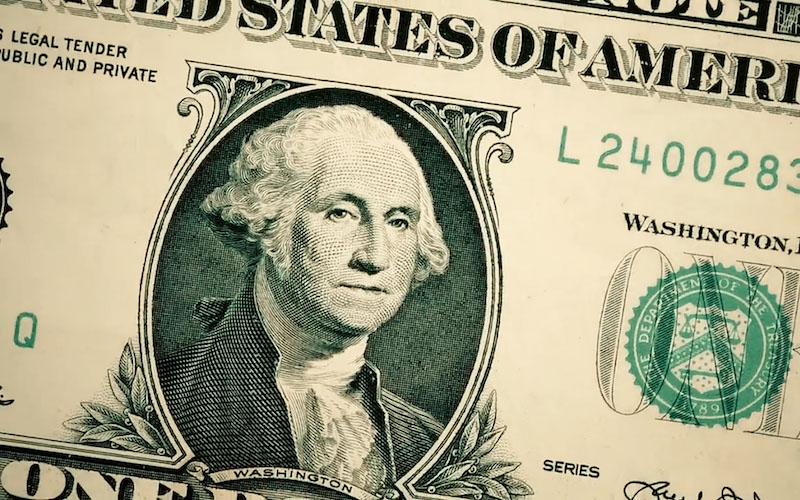The US dollar had a terrifying week: the international trade war has resurfaced, and safe-haven currencies have made a strong comeback!
2025-10-18 12:09:22
Investor sentiment oscillated between brief optimism about trade easing and tit-for-tat tariffs, leading to significant gains in safe-haven currencies such as the Swiss franc and Japanese yen. The euro, benefiting from a temporary reprieve from political turmoil in France, rose 0.28% on a weekly basis. Overall, market risk appetite declined, with the US government shutdown and expectations of a Federal Reserve rate cut further pressuring the US dollar and injecting more uncertainty into global foreign exchange markets.

International trade once eased, and the US dollar quickly weakened after rebounding at the beginning of the week
The foreign exchange market enjoyed a brief respite on Monday (October 13th) as US President Trump's soothing remarks on social media eased trade tensions with China, after he had previously threatened to impose high tariffs on China. The US dollar rebounded strongly against the euro and yen, and rose more than 0.5% against the Swiss franc, pushing the US dollar index back up 0.42% to 99.25 after last week's sharp drop.
Traders viewed this as a reversal of risk aversion, temporarily strengthening the dollar's status as a major safe haven. However, this optimism was quickly shattered by reality. On Tuesday, Sino-US relations deteriorated again, with China launching an investigation into the US shipping industry and adding several US subsidiaries to a list of countermeasures, undermining the conciliatory tone of the weekend. The dollar fell 0.37% against both the Swiss franc and the Japanese yen, with market risk appetite plummeting and investors questioning the long-term impact of the trade dispute.
The escalation of trade frictions and the Fed's signals have led to the US dollar falling for three consecutive days.
The international trade war intensified mid-week, with China tightening its rare earth export controls, a move US officials slammed as a threat to the global supply chain. On Wednesday, the US dollar continued to decline against the euro and yen, and fell another 0.5% against the Swiss franc, sending the US dollar index falling for the second consecutive day to 98.65.
The focus was on Federal Reserve Chairman Powell's speech, in which he emphasized the sluggish U.S. labor market and did not rule out the possibility of further interest rate cuts, which echoed signs of economic weakness mentioned in the Beige Book report, including increased layoffs and reduced household spending.
On Thursday, trade tensions continued to simmer, with China rejecting US calls to lift rare earth metal controls. The US dollar extended its decline, falling 0.49% against the Swiss franc to 0.7927 and 0.4% against the Japanese yen. Dovish comments from Federal Reserve officials, with both Governors Waller and Milan supporting a more aggressive path of interest rate cuts, further pressured the dollar. Low US Treasury yields also diminished the dollar's appeal.
Risk aversion dominated the end of the week, with the euro and the Australian dollar fluctuating
Despite a slight 0.2% rebound on Friday, the US dollar still posted a 0.3% weekly loss. It hit a one-month low of 0.7872 against the Swiss franc and briefly fell below the 150 mark against the Japanese yen to 149.38. The US dollar index closed at 98.53 on Friday. The safe-haven Swiss franc and Japanese yen stood out this week, with the former posting its biggest weekly gain since June, while the latter, though giving up some of its gains on Friday, still posted a weekly loss. USD/CHF fell 0.8% this week to 0.7934, while USD/JPY fell 0.47% this week to 150.58.
The yen was supported by cautious comments from Bank of Japan officials, with Governor Kazuo Ueda saying he was ready to raise interest rates if economic forecasts materialize, offsetting some of the pressure from the trade war.
The euro outperformed this week, rising 0.28% to 1.1652 against the dollar, mainly due to the French government's suspension of pension reforms and Prime Minister Le Corny's survival of a no-confidence vote, easing political uncertainty.
In contrast, the Australian dollar experienced significant volatility. It rose 0.7% at the start of the week amid a rebound in risk appetite, but was dragged down midweek by the impact of international trade and weak Australian employment data. It closed at 0.6493 on Friday, up 0.23% for the week. The unemployment rate hit a near four-year high, adding to the case for the Reserve Bank of Australia to cut interest rates. The British pound, influenced by UK labor market data, rose 0.6% for the week, despite pressure from a rising unemployment rate to 4.8% and slowing wage growth, supported by a falling US dollar.
Summarize
Overall, the volatility in the foreign exchange market this week highlighted the dominant role of geopolitical risks in currency trends. The repeated international trade wars have turned the US dollar from a safe haven into a source of pressure, and the demand for safe-haven assets has surged.
Looking ahead to next week, the meeting between Trump and Chinese President Xi Jinping will be crucial. If tensions ease further, the US dollar may see a rebound. Conversely, expectations of a rate cut at the Federal Reserve's meeting at the end of October may continue to weigh on the dollar. Investors should closely monitor the progress of the US government shutdown and global economic data to prepare for potential market fluctuations.
According to Xinhua News Agency, on the morning of October 18, Beijing time, the Chinese chief negotiator for China-US economic and trade negotiations, Vice Premier He Lifeng, held a video call with his US counterparts, US Treasury Secretary Jeffrey Bessant and Trade Representative Greer. The two sides had candid, in-depth and constructive exchanges on important issues in bilateral economic and trade relations, focusing on implementing the important consensus reached in previous calls between the two heads of state this year, and agreed to hold a new round of China-US economic and trade consultations as soon as possible.
The news is expected to affect the foreign exchange market next Monday, tending to provide upward momentum for the US dollar, Australian dollar and New Zealand dollar, and negatively impacting the safe-haven demand for the Japanese yen and Swiss franc.
- Risk Warning and Disclaimer
- The market involves risk, and trading may not be suitable for all investors. This article is for reference only and does not constitute personal investment advice, nor does it take into account certain users’ specific investment objectives, financial situation, or other needs. Any investment decisions made based on this information are at your own risk.





















